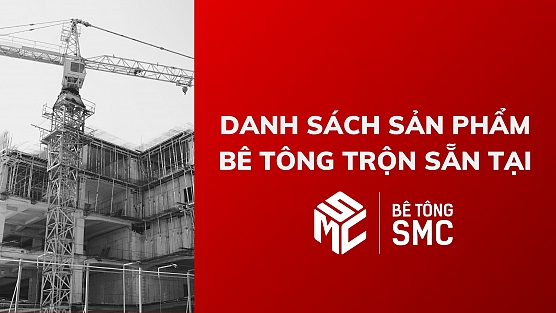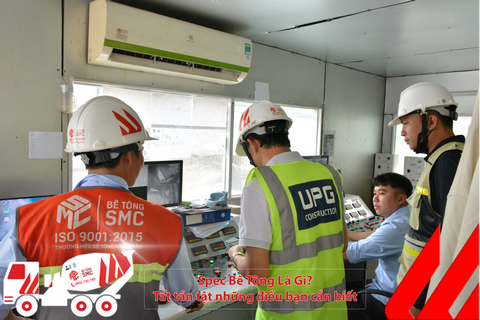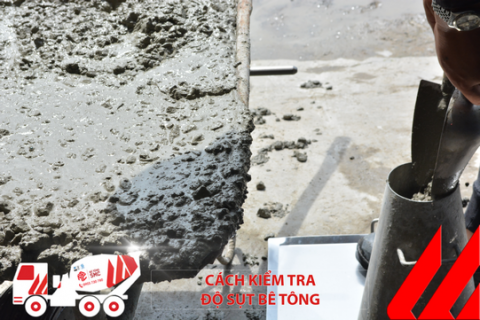Frequently asked Questions
Concrete engineering advice
Business contact
Precast Concrete Box Culverts: The Optimal Solution for Drainage Systems
Precast concrete box culverts are the optimal solution for drainage systems. Discover the structural standards and practical applications in SMC's article.
What is a Precast Concrete Box Culvert?
A precast concrete box culvert is a type of structure in the precast concrete group, designed to bear loads based on the specific technical requirements of each project. With its high load-bearing capacity, this type of culvert can be used in areas where vehicles pass directly over, as long as load calculations are carefully performed to ensure safety for both people and vehicles.
In practice, precast concrete box culverts are commonly used in infrastructure systems such as stormwater drainage, domestic wastewater systems, protection for electrical and telecommunication cables, or other technical pipes. Due to their flexibility in installation and high durability, they are the optimal choice for many modern construction projects.
Types of Precast Concrete Box Culverts
In modern infrastructure construction, precast concrete box culverts are categorized based on two main criteria: cross-sectional shape and structure. Choosing the right type of box culvert for each project will optimize construction efficiency and ensure long-term durability.
2.1 Classification by Cross-Section Shape
Based on the shape of the cross-section, precast concrete box culverts are divided into:
-
Rectangular box culverts
-
Square box culverts
Each type comes in various sizes to meet the diverse needs of different projects, from urban drainage systems to heavy-load transportation works.
2.2 Classification by Structure
In terms of structure, the products are divided into:
-
Single box culverts
-
Double box culverts
A double box culvert is made from two single box culverts and may have different widths, though they usually share the same height for easier production and installation.
Advantages of Double Box Culverts over Single Box Culverts:
-
Optimized installation space: In areas with limited construction space but a high water flow requirement, double box culverts help save space by reducing the wall thickness between the two culverts and the joint gap.
-
Faster installation: Installing double box culverts is significantly faster than installing two separate single box culverts, thus shortening the overall project timeline.
Advantages and Disadvantages of Precast Concrete Box Culverts
In the process of building drainage systems and regulating flow, precast concrete box culverts are increasingly becoming the preferred choice for many contractors. Replacing traditional channels and ditches, this product provides superior performance due to its outstanding advantages listed below:
Advantages:
-
Wide range of applications: Precast concrete box culverts are widely used in various types of projects, including urban drainage systems, underground infrastructure, industrial zones, residential areas, transportation roads, and even systems for treating medical or industrial wastewater containing hazardous chemicals.
-
High durability and excellent load-bearing capacity: Made from high-quality concrete and reinforced steel, these culverts have a long lifespan and excellent resistance to forces, suitable for both large and small projects.
-
Weather and environmental resistance: Precast concrete box culverts are not significantly affected by harsh weather conditions, minimizing repair and maintenance costs.
-
Effective water-tightness: Due to tightly sealed joints using specialized rubber gaskets, the product almost eliminates leakage. This is crucial for preventing harmful waste from seeping into the surrounding environment.
-
Larger drainage capacity than round culverts: The box shape allows for superior water containment and drainage capacity, especially in areas with high water flow.
Disadvantages:
-
Relatively long installation time: Due to their large weight, the transport and installation process requires specialized equipment, making them unsuitable for projects with tight deadlines or limited space.
Structural Standards for Precast Concrete Box Culverts
To ensure quality and safety during construction, precast concrete box culverts must adhere to the technical requirements specified in the National Standard TCVN 9116:2012. This standard applies to both single and double box culverts used in underground projects such as drainage systems, underground utilities, and telecommunications cables.
4.1 Material Requirements for Precast Concrete Box Culverts
-
Cement: Common types include Portland cement (PC), mixed Portland cement (PCB), and sulfate-resistant Portland cement (PCSR), depending on environmental conditions and design.
-
Aggregates:
-
Fine aggregates: Natural sand or crushed sand, meeting TCVN 7570:2006 standards.
-
Coarse aggregates: Crushed stone or gravel, meeting TCVN 7570:2006 standards and design requirements.
-
-
Water: Must meet TCVN 4506 standards, used for mixing and curing concrete.
-
Additives: Mineral or chemical additives can be used to enhance concrete properties, provided they meet TCVN 8826:2011 and TCVN 8827:2011 standards.
-
Concrete: The concrete mix must achieve the designed strength and waterproof capacity, with a water/cement ratio not exceeding 0.45, and the mix proportions designed based on actual construction conditions.
-
Reinforcement Steel:
-
Reinforcement steel: Hot-rolled steel according to TCVN 1651-1:2008 and 1651-2:2008.
-
Structural steel: Rolled steel according to TCVN 6288:1997.
-
Installation tolerances: The installation tolerance should not exceed ±10 mm for reinforcement and stirrups, and ±5 mm for the concrete cover.
-
Concrete cover: The minimum thickness of the concrete cover should be 12 mm on both the inside and outside to prevent corrosion.
-
4.2 Surface Quality and Product Shape Requirements
-
Surface: The precast concrete box culverts must have a smooth, even surface, with a deviation of no more than ±5 mm. Any indentations should not exceed 12 mm in depth.
-
Shape: The vertical axis must be straight, and the deviation from the perpendicular at the ends of the culvert should not exceed ±5 mm.
-
Concrete defects: The area of chips should not exceed the allowed limit and should not affect the interior or exterior surfaces of the culvert. Any chips should be smaller than three times the squared dimension error.
-
Cracks: Shrinkage cracks should not exceed 0.1 mm in width.
-
Stains and leaks: No signs of steel corrosion or water leakage should appear through the culvert walls.
-
Joints: The joints must be sealed with cement mortar that has the same strength as the concrete to ensure tightness.
-
Load-bearing capacity: The box culverts must meet the technical requirements for load-bearing capacity according to the design to ensure long-term safety.
Construction Process for Precast Concrete Box Culverts
Precast concrete box culverts are the top choice for modern drainage systems due to their high durability, excellent load-bearing capacity, and fast installation. To ensure quality, the production and casting of box culverts need to be strictly followed, from material selection to construction.
5.1 Material Preparation
To ensure the product meets technical standards, the materials used in the construction of precast concrete box culverts must meet the following requirements:
-
Cement, steel: High-quality materials ensuring load-bearing capacity and durability as per the design.
-
Stone: Clean stone, free from impurities. The flat stone ratio should not exceed 15% to avoid affecting the concrete's bonding strength.
-
Building sand: Coarse, solid sand, free from mud and organic impurities.
-
Water for mixing concrete: Clean water meeting technical standards to ensure proper setting and strength development.
5.2 Construction Steps
-
Mixing concrete: Use a large mixer (around 500 liters) to ensure a uniform mix. The materials' weight must be precisely measured based on the designed mix ratio.
-
Preparing reinforcement and formwork: The reinforcement steel should be cleaned before installation. The formwork must be coated with a release agent for easy removal after the concrete sets.
-
Pouring concrete: After the reinforcement and formwork are inspected, proceed with pouring the concrete in layers of 15-20 cm. Use a vibrator to remove air bubbles and ensure the product’s density. Continuously check the formwork during the process to prevent deformation.
-
Curing: After pouring, cover the surface with burlap and water regularly to keep moisture and prevent cracking due to shrinkage, ensuring the curing process meets the standards.
5.3 Advantages of Precast Concrete in Modern Construction
Not just box culverts, many other precast concrete elements such as precast walls, fire-resistant partitions, and precast fences are gradually replacing traditional concrete pouring methods. This is due to their outstanding advantages:
-
Consistent quality, easy to control.
-
Significantly shortened construction time.
-
Excellent fire resistance, waterproofing, and corrosion resistance.
-
High aesthetic value, suitable for many types of projects.
-
Green construction, environmentally friendly.
Thanks to these superior characteristics, precast concrete is considered a sustainable construction trend, perfectly suited to the needs of modern infrastructure development in industrial zones, urban areas, and residential buildings.
Order Ready-Mix Concrete and Concrete Pumping Services at SMC
If you're looking for high-quality ready-mix concrete and reliable concrete pumping services, SMC is your top choice. We are committed to delivering products that meet technical standards, with superior durability, alongside professional and efficient concrete pumping services.
SMC continuously strives to improve production processes, applying modern technology to produce the highest quality concrete products. Additionally, we always ensure the most competitive prices in the market, aiming to satisfy all customers.
Other news
Currently, ready-mix concrete is a top choice for many construction projects—both large and small—thanks to its convenience, consistent quality, and high construction efficiency. With extensive experience supplying commercial concrete for numerous key projects in the Southern region, SMC proudly offers a diverse range of ready-mix concrete products to meet the technical requirements of every type of construction.
A Comprehensive Guide to Concrete Specs – Everything You Need to Know
A Complete Guide to Concrete Specs – a set of technical parameters including concrete grade, slump, compressive strength, aggregate size, and mix ratio. This article helps you understand how to define, apply, and control concrete quality according to TCVN standards and practical construction conditions.
How to check the concrete slump
In construction and civil engineering, concrete slump test (or simple slump test) is the work performed at the construction site or in the laboratory that usually determines and measures the hardness, consistency of samples. Concrete before pouring concrete or casting maintenance, research or experiment samples.




